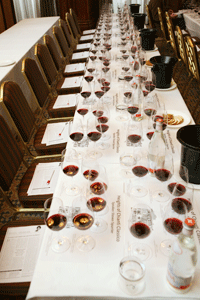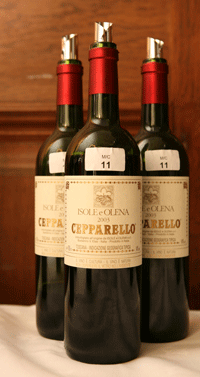Speaker: Steven Spurrier
The idea for this masterclass was stimulated by the claim, made by Decanter’s consultant editor Steven Spurrier in his monthly column in the magazine, that ‘by the beginning of the next decade, Chianti Classico will be replacing the Médoc in many a wine lover’s cellar’.
 Spurrier’s thinking was that Chianti is now a much more vineyard-driven region than its Bordelais counterpart, which has become market-driven. Keen to put this theory to the test, we invited a dozen of the top Chianti Classico producers over from Tuscany to seduce our traditionally claret-loving audience.
Spurrier’s thinking was that Chianti is now a much more vineyard-driven region than its Bordelais counterpart, which has become market-driven. Keen to put this theory to the test, we invited a dozen of the top Chianti Classico producers over from Tuscany to seduce our traditionally claret-loving audience.
Spurrier reprised his role as their champion, introducing each speaker and again holding forth on the merits of the region. ‘It is remarkable,’ he said, ‘given that the wine of Chianti dates back to the 14th century, that a revolution in quality has happened in the space of a single generation.’ That generation sat before us, and Spurrier praised the work they had done in the vineyard, where ‘since 1992, over half the 10,000 hectares of Chianti Classico have been replanted, at high density, with careful clonal selection, precise identification of the zones best suited to Sangiovese; and clearer ideas of which grapes best compliment it.’
The 12 producers certainly provided ample evidence of the fruits of these labours. Concentrating almost exclusively on the stellar 2004 vintage, they showcased a rich array of noteworthy wines. That so many of the wineries’ owners were present to field questions from a noticeably engaged audience spoke volumes for the level of interest on both sides of the commercial equation: consumers are treating Chianti as a wine of serious intent (questions covered such topics as ageability, yields, oak treatment and the suitability and typicity of the various blends); and the producers aspire to be held in the same esteem as the other great regions of the wine world.
This was perhaps best evidenced by the three fairly distinct categories of wine now confidently emerging each year from most producers’ cellars, and seen here: a non-Riserva Chianti from the most recent vintage; a Riserva from an older vintage; and an IGT Supertuscan The latter still held sway over many guests’ palates, thanks in no small part to Querciabella’s Camartina and Isole e Olena’s Cepparello, but no longer is it seen by producers – or consumers – as the sole preserve of ‘serious, ageworthy’ wines from this celebrated part of Tuscany.

| Wines: | Badia a Coltibuono – Chianti Classico Riserva DOCG 2004 (speaker: Emanuela Stucchi Prinetti – Owner)
Rocca di Montegrossi – San Marcellino, Chianti Classico DOCG 2004 (speaker: Marco Ricasoli Firidolfi – Owner) Castello di Volpaia Chianti Classico Riserva DOCG 2004 (speaker: Giovanella Stianti – Owner) Molino di Grace – Il Margone, Chianti Classico Riserva DOCG 2004 (speaker: Tiziano Vannoni – Assistant Director) Nittardi – Nittardi, Chianti Classico Riserva Selezionato DOCG 2004 (speaker: Leon Femfert – Owner) Marchesi Mazzei – Castello di Fonterutoli, Chianti Classico DOCG 2004 Barone Ricasoli – Castello di Brolio, Chianti Classico DOCG 2004 (speaker: Francesco Ricasoli – Owner) Fontodi – Vigna del Sorbo, Chianti Classico Riserva DOCG 2004 (speaker: Giovanni Manetti – Owner) Felsina – Fontalloro IGT Toscana 2004 (speaker: Giuseppe Mazzocolin – Owner & manager) Querciabella – Camartina IGT Toscana 2004 Isole e Olena – Cepparello IGT Toscana 2003 (speaker: Luca de Marchi) San Fabiano Calcinaia – Cerviolo Rosso IGT Toscana 1999 (speaker: Guido Serio – Owner) |
The Great Italian Decanter Fine Wine Encounter 2008
Written by






